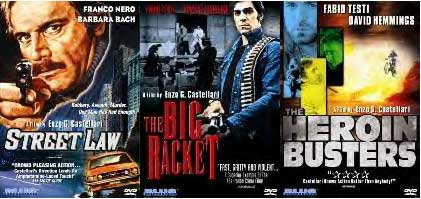 STREET
LAW (1974)
STREET
LAW (1974)A sliver in the side of the polite one-sided moral parables of early American and British crime thrillers, the Italian crime genre, termed Poliziotteschi, is as known for challenging the morally rigid, unrealistic championed moral caricatures of the Western cinematic status quo as for shocking the cinematic world with its unabashed celebrations of brutality, sleaze, and harshness.
Owing much to
the seedy atmosphere and camera work of the Noir films which stabbed a hole
in the illusive carpet of morality decades before, the Poliziotteschi were also
clearly inspired by the dual influence of American revenge movies and, perhaps
more importantly, the corrupt politics and violence of their own land, painting
the streets red with blood and riddling faith with bullets. At best, the Italian
crime movie is a gritty celebration of high-adrenaline action and social commentary,
inviting audiences to indulge in violence via the screen while warning against
falling pray to it in waking life. An unnerving filth-and-lead portrait of politically
dangerous and revolutionary times, the Italian crime thriller is one mean costumer.
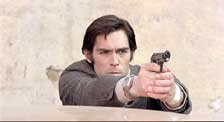
Refusing to play it safe during an artistic and cultural era when a majority of crime films were still reinforcing a naïve insistence on the heavy-handed, one-sided moral rigidity of unbendable Good vs. inflexible Evil, the Italian thriller found lechery and shadows where American films saw (or would only admit to) only black-and-white stereotypical definitions of law and crime, good and bad. Until DIRTY HARRY, DEATH WISH, and their ilk, Western cinema largely refused to depict screen idols in anything but clean-cut fashion, allowing for none of the rough edges, vices, or downright psychotic characteristics of Italian crime cinema. Recycling a family-friendly (if largely false) image of moral superiority by instilling characters on the side of the law with unbreakable moral fortitude – whatever the flavor of the status quo’s perception of righteousness was at the time – the American crime film, like the American Western before it, disappointed audiences hungry for torrid spectacle and the unsavory attractiveness of the anti-hero. What studios couldn’t (or refused) to present in their clean-cut Saturday Matinee fantasies of unrealistic moral codes, the Italians supplied with rigor and brutal grace, churning out a slew of ball-busting, white-knuckle police dramas of an Italian aesthetic.
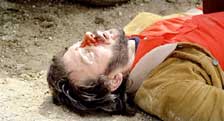 As
intelligent as they are violent, unrepentantly daring in execution, cynically
ruthless in their depiction of dirty angels and even dirtier devils, the crime
films of Enzo G. Castellari (real name Enzo Girolam) are anything but tame or
predictable. Often unfairly derided for cheap product and slap-dash directing,
Castellari accomplished much with very little. Often working with little budget,
uncooperative actors, and hurried time frames, he more often than not always
managed to produce an entertaining (and sometimes thoughtful) movie. Uninspired
in developing subtle moments of character introspection, Castellari’s
strength is in using the basic traits of a character, and the conflict of a
story, to paint broad – not subtle – portraits of fiery action and
sprawling violence. A director of action, his characters are as large and generally
symbolic as his plots. And he’s never afraid to depict even ‘the
good guys’ in hues of gray. His angels have horns, and his criminals can
wear haloes.
As
intelligent as they are violent, unrepentantly daring in execution, cynically
ruthless in their depiction of dirty angels and even dirtier devils, the crime
films of Enzo G. Castellari (real name Enzo Girolam) are anything but tame or
predictable. Often unfairly derided for cheap product and slap-dash directing,
Castellari accomplished much with very little. Often working with little budget,
uncooperative actors, and hurried time frames, he more often than not always
managed to produce an entertaining (and sometimes thoughtful) movie. Uninspired
in developing subtle moments of character introspection, Castellari’s
strength is in using the basic traits of a character, and the conflict of a
story, to paint broad – not subtle – portraits of fiery action and
sprawling violence. A director of action, his characters are as large and generally
symbolic as his plots. And he’s never afraid to depict even ‘the
good guys’ in hues of gray. His angels have horns, and his criminals can
wear haloes. 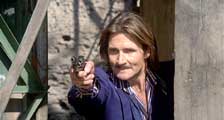
Good and evil are but terms, void of any real meaning, in the world depicted in Castellari’s spaghetti approach to crime and vengeance, infused with brutal tragedy and power abuse. In each of the following three films released by Blue Underground, the legal and political systems themselves are the worst offenders – the legal loophole and corrupt mechanism within which cop, crook, and citizen make one another suffer while politicians and mob bosses (often one and the same) watch from above. Castellari understands this, and depicts his lawmen accordingly. His ‘boys in blue’ are ‘heroes’ in only the flimsiest use of the word if judged by modern conceptions, defying the idolized hero of Golden Age Hollywood, diluted television, and a society that says one thing only to do another. Italian law officers are more closely related to the ‘heroes’ of ancient Greek mythology who, despite their ridiculous defacement on recent television, were often as cruel and violent as they were courageous, as destined for tragedy as they were for greatness. Here the similarity ends, for the ‘heroes’ or ‘anti-heroes’ in Italian crime cinema are often destined for shame, familial estrangement, cultural alienation, or death.
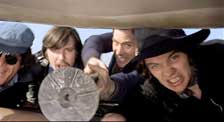 And,
for those who look for nothing other than exploitative thrills, break-neck action,
and skull crashing violence, they hit the spot as well! While not sharing the
Italian horror or giallo movie’s preoccupation with close-up, lovingly
detailed viscera or gore (as fun as that can be!), amazing bursts of prolonged
brutality are featured in these movies, as central to their success (perhaps
more so) than the acting talents of even Fabio Testi or Franco Nero. Bodies
are the corrupt world in miniature, ravaged by criminal and criminally inclined
cop alike. Bodies are beaten, burned, shot, garroted, stabbed, ran over, slapped,
punched, tortured, and raped. They are meat in a butcher shop of cinema, and
Castellari’s voyeuristic camera captures every blistering head wound and
bloody squib. While not as emotionally effective or viscous as Mario Bava’s
RABID DOGS, nor as cynically painful as REVOLVER, Blue Underground’s presentations
of STREET LAW, THE BIG RACKET, and THE HEROIN BUSTERS are significant, highly
entertaining examples of this unflinching existential movie genre. Cerebral,
gut-punching brawls, sexual deviancy, corrupt power-plays between officials,
and requisite good-cops-gone-bad shoot up the city in these wonderfully presented,
gorgeous looking spaghetti thrillers, completely uncut!
And,
for those who look for nothing other than exploitative thrills, break-neck action,
and skull crashing violence, they hit the spot as well! While not sharing the
Italian horror or giallo movie’s preoccupation with close-up, lovingly
detailed viscera or gore (as fun as that can be!), amazing bursts of prolonged
brutality are featured in these movies, as central to their success (perhaps
more so) than the acting talents of even Fabio Testi or Franco Nero. Bodies
are the corrupt world in miniature, ravaged by criminal and criminally inclined
cop alike. Bodies are beaten, burned, shot, garroted, stabbed, ran over, slapped,
punched, tortured, and raped. They are meat in a butcher shop of cinema, and
Castellari’s voyeuristic camera captures every blistering head wound and
bloody squib. While not as emotionally effective or viscous as Mario Bava’s
RABID DOGS, nor as cynically painful as REVOLVER, Blue Underground’s presentations
of STREET LAW, THE BIG RACKET, and THE HEROIN BUSTERS are significant, highly
entertaining examples of this unflinching existential movie genre. Cerebral,
gut-punching brawls, sexual deviancy, corrupt power-plays between officials,
and requisite good-cops-gone-bad shoot up the city in these wonderfully presented,
gorgeous looking spaghetti thrillers, completely uncut!
STREET LAW
Closely resembling
the vengeance-of-the-common-man theme of DEATH WISH, this first volume of the
series is perhaps also the meanest spirited; it also happens to be one of the
great vengeance movies to ever paint the screen red with rage and blood, following
the descent of a once respectable man into his quest for retribution. 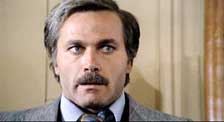
Carlo Antonelli (legendary, steely-eyed Franco Nero) is the very essence of personal vengeance and enflamed rage. An ordinary, convincingly played man of understandable habits and harmless disposition, Carlo’s world is shattered, his faith in man and law as battered as he is, when, one day, he is attacked by robbers. The sudden brutality of the attack, and its suggestion that the banal expectedness of everyday life can so easily be shattered, flings him into a personal inferno of doubt and rage. When he learns his attackers are out on the street instead of behind bars, his private anger becomes a city’s apocalypse. Realizing that his conception of right and wrong, good and bad, law and crime are empty words, not fixed absolutes in a universe without empathy, Carlo’s experiences with unjust men force him to become just as savage. Castellari realistically captures the pathos and quite madness of Carlo’s break-down, and electrifies the screen in 103 minutes of carnage.
 It’s
easy to find yourself sharing in Carlo’s shame and anger. When his attackers
go unpunished, we understand Carlo’s internal imprisonment of fear, rage,
and helplessness – thanks largely to an involving script and Castellari’s
ability to evoke empathy. The great performance by Nero, the not-so-subtle extravagance
of an action-packed plot, and Castellari’s increasingly confident direction
inject an above-average degree of intelligence and style into a genre more often
noted for its explosions and bullet-play than its transformations of character
It’s
easy to find yourself sharing in Carlo’s shame and anger. When his attackers
go unpunished, we understand Carlo’s internal imprisonment of fear, rage,
and helplessness – thanks largely to an involving script and Castellari’s
ability to evoke empathy. The great performance by Nero, the not-so-subtle extravagance
of an action-packed plot, and Castellari’s increasingly confident direction
inject an above-average degree of intelligence and style into a genre more often
noted for its explosions and bullet-play than its transformations of character
Nero as Carlo
is a sight to behold, busting heads as quickly and ferociously as he shatters
his once firm obedience to law. A polished, slickly produced movie, this title
is perhaps the most involving on a personal level, and potentially the most
controversial to a society weaned on “due process.” Castellari,
in fine form, manages to infuse style and wit into what could have been little
more than a standard crime thriller. The final shootout, as par for the course,
is deep red goodness. If there is little comfort for the individual or society
in this movie, there is plenty of action. 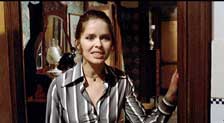
Castellari arranges gunfights and action with confidence. Directing with a minimum of fuss, in all three of these movies he resembles a minimalist fiction writer using as few words as possible to make a point. So too does he evoke the emotional mood and physical action of a scene with a minimum of lighting or false adornment. His films have simple, naturalistic feel that highlights and makes even more intimate their seedy, raw circumstances. Perhaps one of the finest European directors of action alive, his visual ability usually manages to surmount the problems of bad scripts and silly premises.
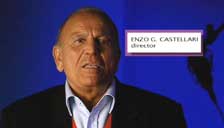 This
feature is clean without any noticeably distracting grain or damage, surprisingly
pristine, with proper coloring and clarity of image. The English audio is a
clear and fresh mono track, raging with gunshots and cries of the dying. Presented
in widescreen (1.85:1and anamorphic), the movie looks and feels like a big-screen
experience. While short on extras, those provided are worthwhile, including
“Laying Down the Law,” which interviews Castellari and Franco Nero
about their careers, the genre, and the movie. This is followed by the expected
television spot and theatrical trailer.
This
feature is clean without any noticeably distracting grain or damage, surprisingly
pristine, with proper coloring and clarity of image. The English audio is a
clear and fresh mono track, raging with gunshots and cries of the dying. Presented
in widescreen (1.85:1and anamorphic), the movie looks and feels like a big-screen
experience. While short on extras, those provided are worthwhile, including
“Laying Down the Law,” which interviews Castellari and Franco Nero
about their careers, the genre, and the movie. This is followed by the expected
television spot and theatrical trailer.
THE BIG
RACKET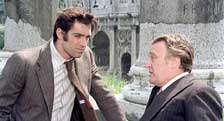
The second of this Italian crime series directed by spaghetti western veteran Enzo C. Castellari, THE BIG RACKET, is also perhaps one of the finest. Nico Palmieri, played by the psychologically provocative, coldly staring Fabio Testi, works as a police inspector battling hoodlums and the indifference of both citizens and politics. Lean and mean in a convincingly rural looking Italian village whose sleepy atmosphere makes for a nice contrast against the script’s knuckle-crashing, broken-teeth violence, Nico battles low-level criminals forcing small businesses to pay them in an attempt to discover their leader. Played for realism and reflecting the distrust and unrest of the times, many of the villagers refuse to assist him. One man who possesses the courage to take a stand, a restaurant owner (played by Renzo Palmer), spills what he knows. In retaliation, his daughter is raped, bringing the story into line with the revenge exploitation movies so popular in the late 1970s and early 1980s. When Nico is ordered off the case by his superiors in a scene embodying the level of corruption and inner-sanctum politics active in just about every branch of government, he snarls, grits his teeth, and decides to stand alone against a political-mob connection. Recruiting allies from amongst the victims of the organization’s lechery, tension penetrates the movie like hot lead through vests. The ending, arriving suddenly and without warning, is a hard kick to the gut, and celebrates the art of violence while thematically condemning the circumstances that make beasts of men.
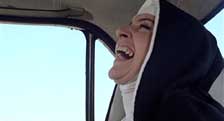 Castellari
delivers a movie equal parts revenge tragedy and expose of corruption. His direction
here is witty and stylish, using the camera, angling, and a sound sense of pace
to make the technical aspects integral in the development of this story. Setting
is also crucial, in this case exposing beneath/within its respectable appearance
the filth, violence and deceit lurking alongside ineffectual laws. In this sense
setting is no less a character than the men who are treated here as living,
breathing people. Character as an aesthetic concept is taken more seriously
here than is usual in exploitation. Portraits of varying social classes and
individuals with distinct histories are emphasized alongside a fistful of gun
battles, bloody squibs, and foul-mouths. Believable performances are given by
Renzo Palmer (as Gestore) and Vincent Gardenia (as Pene) as well as the always
dependable Testi.
Castellari
delivers a movie equal parts revenge tragedy and expose of corruption. His direction
here is witty and stylish, using the camera, angling, and a sound sense of pace
to make the technical aspects integral in the development of this story. Setting
is also crucial, in this case exposing beneath/within its respectable appearance
the filth, violence and deceit lurking alongside ineffectual laws. In this sense
setting is no less a character than the men who are treated here as living,
breathing people. Character as an aesthetic concept is taken more seriously
here than is usual in exploitation. Portraits of varying social classes and
individuals with distinct histories are emphasized alongside a fistful of gun
battles, bloody squibs, and foul-mouths. Believable performances are given by
Renzo Palmer (as Gestore) and Vincent Gardenia (as Pene) as well as the always
dependable Testi.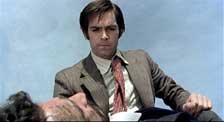
Clearly influenced by the pathos and violently surreal atmosphere of the Spaghetti Westerns, which themselves helped kill the morally one-sided hero-myth of an old west far dirtier and amoral than John Ford showed it, Castellari’s crime films peel back the blister of social convention and shows us the seeping wound beneath. It’s not pretty, nor should it be. Beautiful, yes, but in much the same subversive, threatening way that a Giallo’s violence is poetic. The poetry of the bloodshed and debauchery forces us to question ourselves as much as the actions of people we’re never sure if we should love or hate.
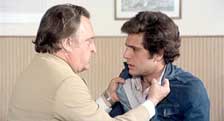 Cop
and society live in as hostile a relationship to one another as the cop and
criminal. The same society that hates Testi’s detective hates him, just
as he detests and yet despairs for it, knowing all too well that its helpless
to halt its streets from being filled with drugs, extortion, and violence. This
warped, unhealthy relationship further illustrates one of the fundamental differences
between traditional crime cinema and the mean-spirited, rough-knuckled punch
of the Italian approach. There are no heroes in these films, for even the representatives
of the law must work below and beyond the accepted code of the system they work
for if they want real justice – itself a flimsy concept exposed in the
movies of director Enzo G. Castellari’s as violent, cynical splatter nightmares
of corruption. Justice is a hard fist and a machine gun fully loaded, as unstable
as any one of his low-life child rapists or psychotic cops. Truth is riddled
with bullets in Castellaris’ unflinching visions of vengeance. And perception,
the tool that both aids and damns his anti-hero detectives and police officers,
is at best highly subjective, at worst capable of making a bad situation even
worse as decent men trying to uphold the law discover that the its political
offices are, finally, filthier than the lowest of scum on the waterfront. The
law doesn’t promise justice, it thwarts it. And the typical Italian crime-fighter
becomes exactly what he hates in wondrous exploitation bravado in a psychotic
determination to exact revenge where no compromise is possible.
Cop
and society live in as hostile a relationship to one another as the cop and
criminal. The same society that hates Testi’s detective hates him, just
as he detests and yet despairs for it, knowing all too well that its helpless
to halt its streets from being filled with drugs, extortion, and violence. This
warped, unhealthy relationship further illustrates one of the fundamental differences
between traditional crime cinema and the mean-spirited, rough-knuckled punch
of the Italian approach. There are no heroes in these films, for even the representatives
of the law must work below and beyond the accepted code of the system they work
for if they want real justice – itself a flimsy concept exposed in the
movies of director Enzo G. Castellari’s as violent, cynical splatter nightmares
of corruption. Justice is a hard fist and a machine gun fully loaded, as unstable
as any one of his low-life child rapists or psychotic cops. Truth is riddled
with bullets in Castellaris’ unflinching visions of vengeance. And perception,
the tool that both aids and damns his anti-hero detectives and police officers,
is at best highly subjective, at worst capable of making a bad situation even
worse as decent men trying to uphold the law discover that the its political
offices are, finally, filthier than the lowest of scum on the waterfront. The
law doesn’t promise justice, it thwarts it. And the typical Italian crime-fighter
becomes exactly what he hates in wondrous exploitation bravado in a psychotic
determination to exact revenge where no compromise is possible.
Captured in 1.85:1 anamorphic widescreen, this movie co-stars stars Renzo Palmer, Orso Maria Guerrini, Glauco Onorato, and Sal Borgese. Again, the real stars are the explosive minefields of action, carnage, and adventure packed into every frame. Aside from a sterling print with admirable color hues, the DVD includes a select if exciting choice of extras. First off is an audio commentary with the director, whose intelligence and love of movie-making is somewhat hampered by occasional cynicism. Still, for the most part his commentary is concise and entertaining, lending social depth and cultural commentary to the action. A theatrical trailer completes the attractively assembled package.
A decidedly mean-spirited example of 1970s crime exploitation during its heavy heyday, THE BIG RACKET offers big thrills!
THE HEROIN BUSTERS
The final entry
in director Enzo G. Castellari's crime movie cycle of the 1970s, THE HEROIN
BUSTERS (La via della drogga) was obviously influenced by other vigilante fare,
such as DEATH WISH and DIRTY HARRY. Castellari burrows something of the gritty
Nordic ‘Clan’ sensibility in his stories of vengeance and the personal
rule of justice vs. the cold, unfeeling (and often ineffective) rule of law.
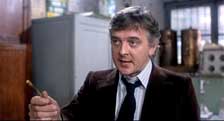
More honest than its American counterparts, this lovingly detailed ode to cinematic slaughter and street chaos is also more stylish – something that can’t always be said about Enzo as a filmmaker (evident in his inept post-apocalyptic entrees). Here his sense of style and penchant for action is in full swing, employing larger-than-life political struggles in an intimate, you-are-there manner. Castellari emphasizes the ancient “eye-for-an-eye” mentality of retribution and justice with surprisingly effective moments of humor between Fabio Testi and David Hemmings, injecting some lightness into an otherwise serious script.
 Featuring
an emotionally involving score by Goblin (DEEP RED), healthy doses of kink,
and all the pulse-pounding violence we know and love from our Italian neighbors,
THE HEROIN BUSTERS is restored for the first time uncut in the States. Fair-faced
thespian Fabio Testi owns the spotlight as a cold-blooded, cynical cop deep
under cover to infiltrate an international drug syndicate. During dizzying montage
shots of international drug trafficking, Fabio poses as a drug dealer conducting
business in the Middle East before returning to beautiful, deadly Rome. Waiting
for him is British Interpol agent Mike Hamilton (Hemmings of BLOW UP and DEEP
RED ), who needs to conceal Fabio's identity as he attempts to expose the ruthless
gangster Gianni (Joshua Sinclair), whose heroin is painting the city streets
white with drugs.
Featuring
an emotionally involving score by Goblin (DEEP RED), healthy doses of kink,
and all the pulse-pounding violence we know and love from our Italian neighbors,
THE HEROIN BUSTERS is restored for the first time uncut in the States. Fair-faced
thespian Fabio Testi owns the spotlight as a cold-blooded, cynical cop deep
under cover to infiltrate an international drug syndicate. During dizzying montage
shots of international drug trafficking, Fabio poses as a drug dealer conducting
business in the Middle East before returning to beautiful, deadly Rome. Waiting
for him is British Interpol agent Mike Hamilton (Hemmings of BLOW UP and DEEP
RED ), who needs to conceal Fabio's identity as he attempts to expose the ruthless
gangster Gianni (Joshua Sinclair), whose heroin is painting the city streets
white with drugs. 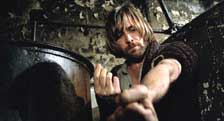
This premise starts out the first half of the film, which, while slower than expected, is purposely measured so as to build character and mood, particularly in the attention paid to drugs as a social problem. In fact, just as much suspense is squeezed from the director’s emphasis on users shooting up their veins as by his attention to violence. When Castellari suddenly does pump up the action, it’s so very effective because we’ve been lulled into false security which he shatters with exciting chase scenes and stunts. Of course with Goblin contributing the score, the music is as much a character as the men whose dramatic actions it unerringly supports with catchy, pulse-pounding acuity.
 The
story veers unblinkingly into a Dante-inspired den of lust and sexual excess.
The director’s insistence on realistic violence adds further tension.
A careful use of eerily quiet moments of non-action is also employed, which
hint at the strained anger and tension, the animal instincts, ready to burst.
Sherry Buchanan (of ZOMBIE HOLOCAUST infamy) makes the movie more fun to look
at as a cat-and-mouse game descends into a city-wide bloodbath. As a director
(and writer) of crime thrillers, Castellari instills reflections of cultural
injustice and political relevance into crime cinema, layering subtext beneath
the brutality of his macho maneuverings. Besides a stand-out performance by
Testi, a pitifully underrated actor whose star never caught on with the fickle
public as quickly as did such fellows as Frank Nero or George Hilton, the actors
in this tightly-shot fight-fest include Hemmings (mentioned once again because,
well, he’s good!), Buchanan and Sinclair.
The
story veers unblinkingly into a Dante-inspired den of lust and sexual excess.
The director’s insistence on realistic violence adds further tension.
A careful use of eerily quiet moments of non-action is also employed, which
hint at the strained anger and tension, the animal instincts, ready to burst.
Sherry Buchanan (of ZOMBIE HOLOCAUST infamy) makes the movie more fun to look
at as a cat-and-mouse game descends into a city-wide bloodbath. As a director
(and writer) of crime thrillers, Castellari instills reflections of cultural
injustice and political relevance into crime cinema, layering subtext beneath
the brutality of his macho maneuverings. Besides a stand-out performance by
Testi, a pitifully underrated actor whose star never caught on with the fickle
public as quickly as did such fellows as Frank Nero or George Hilton, the actors
in this tightly-shot fight-fest include Hemmings (mentioned once again because,
well, he’s good!), Buchanan and Sinclair. 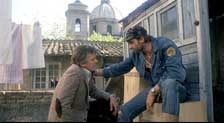
Blue Underground's DVD premiere is excellent, presenting the film in a 1.85:1 anamorphic widescreen transfer from the original camera negative. Picture is captured in sharp detail, with bold colors and minimal print damage. The English-dubbed mono audio is a treat. The sparkling image and color show the respect with which Blue Underground treated these movies. The mono English sound is fine and without interference. In the Castelleri audio commentary, the director waxes enthusiastic about police films in general, his contributions, and how this one came into being – a crash-course lesson in Crime cinema Italian style. The theatrical trailer rounds this one out.
Grim treasures of sight, sound, color, action, and depravity, Blue Underground’s presentations of Enzo C. Castellari’s crime epics are respectfully treated and lovingly restored. While a box set would have been preferable (and will probably surface a year or two down the road, I expect, once folks have purchased them separately!) their presentation of these uncut spectacles of corruption, violence, and amorality are definitely worth the price. Depicting raw men walking the dark-shadow line between righteousness and decadence, this series examines morally ambiguous men with consciences that they sometimes must ignore to do what’s right – finding out what exactly what ‘right’ is, and determining whether society or the individual can or should define it, is the major theme which ties these black eyes on classic Hollywood morality together. Law and truths depend on whose eyes we’re staring out from, and who holds the gun in these repeat offenders of talent, terror, and tension! (William P. Simmons)